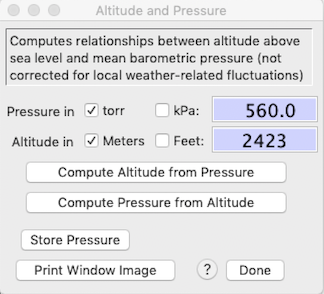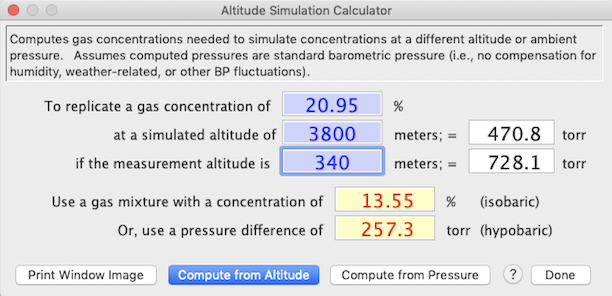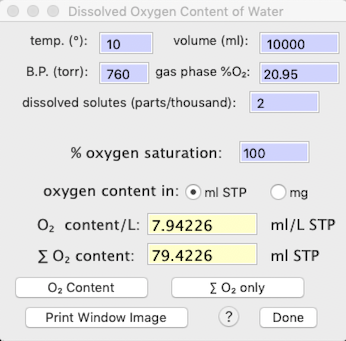|

ALTITUDE
& PRESSURE... 'a' This option computes
an estimate of mean atmospheric pressure as a function of altitude, or vice
versa. It is based on a polynomial approximation of the International
Standard Atmosphere equation, obtained from the Smithsonian Meteorological
Tables (as a rough approximation, pressure decreases by 50% for every 5500
meter increase in altitude). The results should be accurate within
1-2% of actual pressure or altitude, unless weather conditions are really
unusual. Nevertheless, if you use this calculator, you need to keep
a few caveats in mind:
- Due to approximation (and rounding errors), the algorithm is not completely
reversible (for example, the estimated pressure for an altitude of 2200
meters is 576.0 torr, but the estimated altitude for a pressure of 576.0 torr
is 2199.7 meters).
- The results are estimated mean values and do not account for
local pressure fluctuations arising from weather changes.
- The calculator cannot account for any pressure differential inside
your system. For example, if you use a positive-pressure ("push")
respirometry system, the pressure inside the plumbing -- and hence, inside
your flow meter -- will be slightly higher than atmospheric. The
opposite is true for a negative-pressure ("pull") flow arrangement.
If you want to be compulsive, you might consider using a water manometer
or some other pressure gauge to measure the pressure differential and add
that to atmospheric pressure during STP calculations. In most cases, the pressure differential will be small relative to total atmospheric pressure.
- Accuracy will decrease for altitudes above about 9000 meters (or pressures
less than about 230 torr).
- The newest versions let you use kilopascals (kPa) for pressure units,
in addition to torr.
- The 'store pressure' button will save the current value of barometric
pressure.
ALTITUDE
SIMULATION... This computes the concentration of an artificial gas mixture used to simulate gas concentration at a different altitude or pressure. For example, it might be desirable to simulate the hypoxia at high altitude in a near-sea-level laboratory; this is done by using an artificial gas mixture with an oxygen concentration lower than the standard 20.95% atmospheric concentration: e.g., to simulate the oxygen partial pressure at 3,800 meters in a laboratory at sea level, one would use a gas mixture containing about 13% oxygen.
The calculator allows estimations from different altitudes (in which case it estimates ambient pressures from a polynomial approximation of the International Standard Atmosphere equation, obtained from the Smithsonian Meteorological Tables). It also allows estimation directly from user-entered ambient pressures -- this permits adjustments for weather or other local phenomena that shift ambient barometric pressures.

 pO2 and pH2O ESTIMATION... 'o' You
can use this calculator to determine the partial pressure of oxygen (pO2) -- or any other gas species in a mixture -- from
ambient temperature, ambient pressure (in the gas phase), fractional concentration
of the gas species of interest in a dry gas mix, and the percent
saturation of water vapor (i.e., relative humidity) in the gas phase. Oxygen
(or other gases) are diluted by water vapor, and the degree of that dilution
depends on RH and temperature. pO2 and pH2O ESTIMATION... 'o' You
can use this calculator to determine the partial pressure of oxygen (pO2) -- or any other gas species in a mixture -- from
ambient temperature, ambient pressure (in the gas phase), fractional concentration
of the gas species of interest in a dry gas mix, and the percent
saturation of water vapor (i.e., relative humidity) in the gas phase. Oxygen
(or other gases) are diluted by water vapor, and the degree of that dilution
depends on RH and temperature.
In the example at right, pressure is sea level standard atmospheric pressure (760
torr), temperature is the typical mammalian body temperature (37 °C),
etc. Note that at this temperature the saturation vapor pressure of water
is about 47.6 torr (this is not affected by the total pressure in the system).
Other considerations for this calculator:
- The calculated pO2 value is applicable
for the gas phase, and also for dissolved oxygen, as long as the solution
is fully saturated with O2.
- The default pressure (torr or kilopascals, kPa) is obtained from the
current data file; the default temperature is 37 °C, and the default
fractional gas concentration is .2095 (20.95%, the normal oxygen content
of dry atmospheric air).

DISSOLVED OXYGEN... 'w' You
can use this calculator to determine the amount of oxygen dissolved in a given volume water, as a function of partial pressure, temperature, salinity (dissolved solutes), and other factors. Results include both the oxygen content per liter, and the total oxygen content in the specified volume of water. Output units are user-selectable as ml O2 (STP) or mg O2 .
The default salinity value (2 parts/thousand) is reasonable for freshwater. For seawater, use a value of 35 parts/thousand, and for typical physiological saline, use 9 parts/thousand.
In the example at right, pressure is sea level standard atmospheric pressure (760
torr), temperature 10 °C, the water is fully saturated with oxygen,
and there are 2 parts/thousand of dissolved solutes (reasonable for fairly fresh water). The calculator provides the dissolved oxygen per unit volume, and for the total volume.
|

